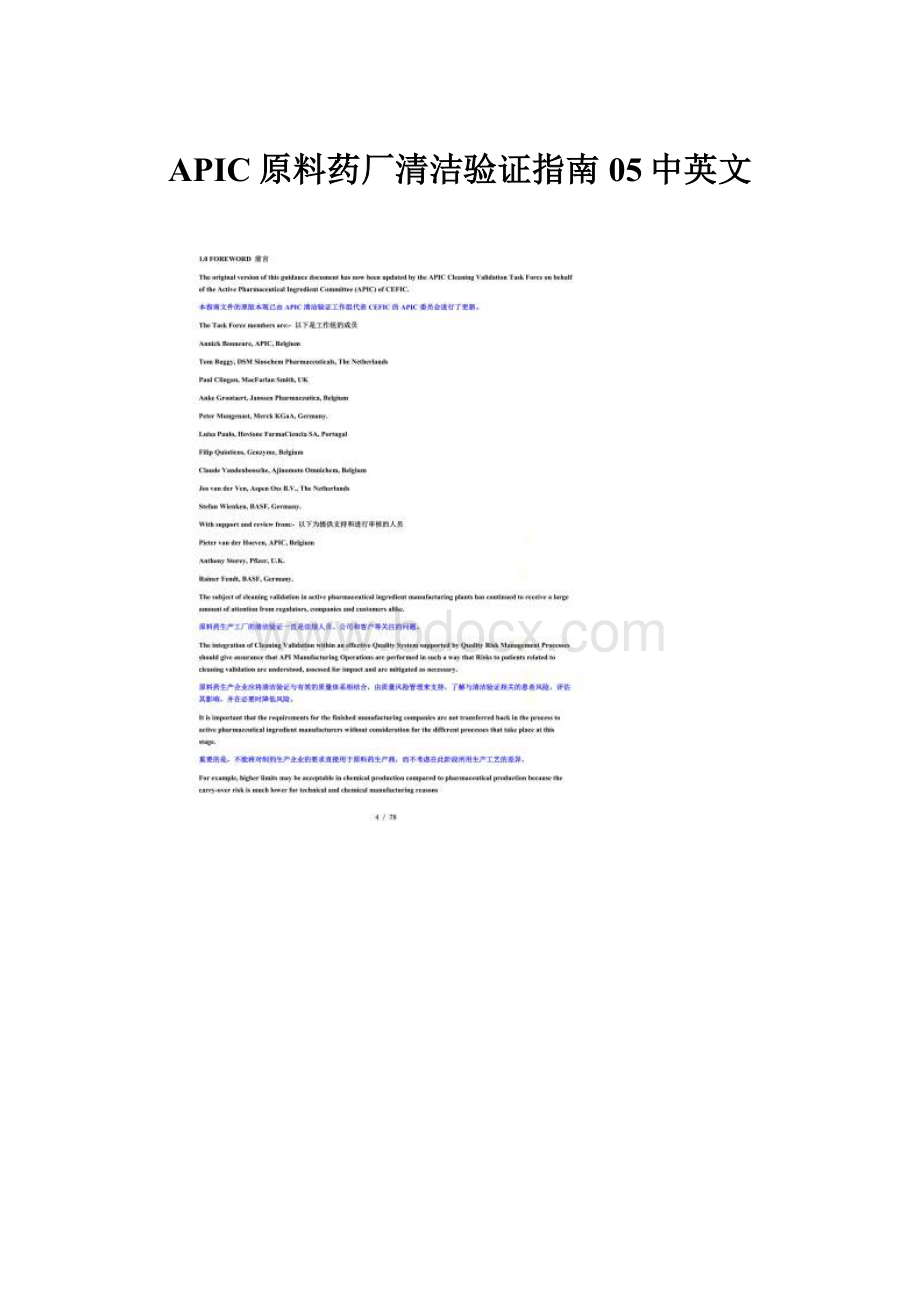 APIC原料药厂清洁验证指南05中英文.docx
APIC原料药厂清洁验证指南05中英文.docx
- 文档编号:11078648
- 上传时间:2023-02-24
- 格式:DOCX
- 页数:106
- 大小:463.05KB
APIC原料药厂清洁验证指南05中英文.docx
《APIC原料药厂清洁验证指南05中英文.docx》由会员分享,可在线阅读,更多相关《APIC原料药厂清洁验证指南05中英文.docx(106页珍藏版)》请在冰豆网上搜索。

APIC原料药厂清洁验证指南05中英文
PIC原料药厂清洁验证指南(201405-中英文)
APIC原料药厂清洁验证指南(201405中英文)
ACTIVEPHARMACEUTICALINGREDIENTSCOMMITTEE(APIC)
GUIDANCEONASPECTSOFCLEANINGVALIDATION
INACTIVEPHARMACEUTICALINGREDIENTPLANTS
APIC原料药工厂中清洁验证指南
May2014
TableofContents
1.0FOREWORD
前言
2.0OBJECTIVE
目的
3.0SCOPE
范围
4.0ACCEPTANCECRITERIA
可接受标准
4.1Introduction
介绍
4.2MethodsofCalculatingAcceptanceCriteria
可接受标准的计算方法
4.2.1.Acceptancecriteriausinghealth-baseddata
使用基于健康数据的可接受标准
4.2.2AcceptancecriteriabasedonTherapeuticDailyDose
基于日治疗剂量的可接受标准
4.2.3.AcceptancecriteriabasedonLD50
基于半数致死量的可接受标准
4.2.4GeneralLimitasacceptancecriteria
作为可接受标准的通用限度
4.2.5SwabLimits
擦拭限度
4.2.6RinseLimits
淋洗限度
4.2.7Rationalefortheuseofdifferentlimitsinpharmaceuticalandchemicalproduction
在药品和化学生产中使用不同限度的合理性
5.0LEVELSOFCLEANING
清洁级别
5.1Introduction
介绍
5.2CleaningLevels
清洁级别
5.3CleaningVerification/Validation
清洁验收/验证
6.0CONTROLOFCLEANINGPROCESS
清洁过程的控制
7.0BRACKETINGANDWORSTCASERATING
分类法和最差情况分级法
7.1Introduction
介绍
7.2BracketingProcedure
分类法程序
7.3CleaningProcedures
清洁程序
7.4WorstCaseRating
最差情况分级
8.0DETERMINATIONOFTHEAMOUNTOFRESIDUE
残留量检测
8.1Introduction
介绍
8.2ValidationRequirements
验证要求
8.3SamplingMethods
取样方法
8.4AnalyticalMethods
分析方法
9.0CLEANINGVALIDATIONPROTOCOL
清洁验证方案
9.1Background
背景
9.2Purpose
目的
9.3Scope
范围
9.4Responsibility
职责
9.5SamplingProcedure
取样程序
9.6Testingprocedure
分析方法
9.7Acceptancecriteria
可接受标准
9.8Deviations
偏差
9.9Revalidation
再验证
10.0VALIDATIONQUESTIONS
验证问题
11.0REFERENCES
参考文献
12.0GLOSSARY
词汇
13.0COPYRIGHTANDDISCLAIMER
版本及声明
1.0FOREWORD前言
TheoriginalversionofthisguidancedocumenthasnowbeenupdatedbytheAPICCleaningValidationTaskForceonbehalfoftheActivePharmaceuticalIngredientCommittee(APIC)ofCEFIC.
本指南文件的原版本现已由APIC清洁验证工作组代表CEFIC的APIC委员会进行了更新。
TheTaskForcemembersare:
-以下是工作组的成员
AnnickBonneure,APIC,Belgium
TomBuggy,DSMSinochemPharmaceuticals,TheNetherlands
PaulClingan,MacFarlanSmith,UK
AnkeGrootaert,JanssenPharmaceutica,Belgium
PeterMungenast,MerckKGaA,Germany.
LuisaPaulo,HovioneFarmaCienciaSA,Portugal
FilipQuintiens,Genzyme,Belgium
ClaudeVandenbossche,AjinomotoOmnichem,Belgium
JosvanderVen,AspenOssB.V.,TheNetherlands
StefanWienken,BASF,Germany.
Withsupportandreviewfrom:
-以下为提供支持和进行审核的人员
PietervanderHoeven,APIC,Belgium
AnthonyStorey,Pfizer,U.K.
RainerFendt,BASF,Germany.
Thesubjectofcleaningvalidationinactivepharmaceuticalingredientmanufacturingplantshascontinuedtoreceivealargeamountofattentionfromregulators,companiesandcustomersalike.
原料药生产工厂的清洁验证一直是法规人员、公司和客户等关注的问题。
TheintegrationofCleaningValidationwithinaneffectiveQualitySystemsupportedbyQualityRiskManagementProcessesshouldgiveassurancethatAPIManufacturingOperationsareperformedinsuchawaythatRiskstopatientsrelatedtocleaningvalidationareunderstood,assessedforimpactandaremitigatedasnecessary.
原料药生产企业应将清洁验证与有效的质量体系相结合,由质量风险管理来支持,了解与清洁验证相关的患者风险,评估其影响,并在必要时降低风险。
Itisimportantthattherequirementsforthefinishedmanufacturingcompaniesarenottransferredbackintheprocesstoactivepharmaceuticalingredientmanufacturerswithoutconsiderationforthedifferentprocessesthattakeplaceatthisstage.
重要的是,不能将对制剂生产企业的要求直接用于原料药生产商,而不考虑在此阶段所用生产工艺的差异。
Forexample,higherlimitsmaybeacceptableinchemicalproductioncomparedtopharmaceuticalproductionbecausethecarry-overriskismuchlowerfortechnicalandchemicalmanufacturingreasons
例如,与制剂生产相比,化学生产可以接受较高的残留限度,因为技术原因,化学生产所带入后续产品的残留风险会低很多。
ThedocumentreflectstheoutcomeofdiscussionsbetweenAPICmembercompaniesonhowcleaningvalidationrequirementscouldbefulfilledandimplementedaspartofroutineoperations.
本文件反映了APIC成员公司之间关于如何满足清洁验证的要求及作为日常操作来实施的讨论结果。
Inaddition,APICisaligningthisguidancewiththeISPERiskMaPPGuide[1]thatfollowstheQualityRiskManagementProcessesasdescribedintheICHQ9GuidanceonQualityRiskManagement.
另外,APIC将本指南与“ISPE基于风险的药品生产指南”保持一致,遵守“ICHQ9质量风险管理”中的“质量风险管理流程”。
ThecriteriaofAcceptableDailyExposure(ADE)isnowrecommendedtobeusedbycompaniestodecideifDedicatedFacilitiesarerequiredornotandtodefinetheMaximumAcceptableCarryOver(MACO)ofAPI’sinparticular,inMulti-PurposeEquipment.
目前推荐公司使用“可接受日暴露水平”标准来决定是否专用设施需要界定原料药“最大可接受残留MACO”,特别是针对多用途设备。
AnewchapterisintroducedtodefinefactorsthatshouldbeconsideredinControlsofTheCleaningProcesstomanagetheRisksrelatedtopotentialchemicalormicrobiologicalcontamination.
放入了一个新章节,对“清洁工艺的控制”中要考虑的因素进行了定义,以管理与潜在化学和微生物污染有关的风险。
ThePDATechnicalReportNo.29–PointstoConsiderforCleaningValidation[2]isalsorecommendedasavaluableguidancedocumentfromindustry.
也推荐企业将“PDA第29号技术报告----清洁验证中应考虑的问题”作为有用的指南文件进行参考。
ThefollowingtopicsarediscussedinthePDAdocument:
Cleaningprocess(CIP/COP):
designandqualification
以下问题在PDA文件中进行了讨论:
清洁工艺(CIP/COP):
设计和确认
—Typesofresidues,settingacceptancecriteria,samplingandanalyticalmethods
—残留类型、设定可接受标准、取样和分析方法
—Maintenanceofthevalidatedstate:
criticalparametersmeasurements,processalarms,changecontrol,trending&monitoring,trainingandperiodicreview
—维护验证状态:
关键参数测量、工艺警示、变更控制、趋势&监控、培训和周期性评审
—Documentation
—文件记录
2.0Objective目的
Thisdocumenthasbeenpreparedtoassistcompaniesintheformulationofcleaningvalidationprogrammesandshouldnotbeconsideredasatechnicalstandardbutastartingpointforinternaldiscussions.Thedocumentincludesexamplesonhowmembercompanieshavedealtwithspecificareasandissuesthatarisewhenperformingcleaningvalidation.
本文件的目的是帮助公司制订清洁验证程序,不能作为是一个技术标准,只应该作为内部讨论的出发点。
本文包括了成员公司如何处理其特殊领域的例子,以及在实施清洁验证时提出的问题点。
3.0Scope范围
SixspecificareasareaddressedinthisGuidancedocument:
本指南文件包括6个方面
●AcceptanceCriteria
●可接受标准
●LevelsofCleaning
●清洁水平
●Controlofthecleaningprocess
●清洁工艺的控制
●BracketingandWorstCaseRating
●分类法和最差情况分级
●Determinationoftheamountofresidue
●残留量的检测
●CleaningValidationProtocol
●清洁验证方案
Finally,themostfrequentlyaskedquestionsareansweredtogivefurtherguidanceonspecificpointsrelatedtocleaningvalidation.
最后是一些常见问题及回答,对一些与清洁验证有关的特殊情况给予指导。
4.0AcceptanceCriteria可接受标准
4.1.Introduction概述
Companiesmustdemonstrateduringvalidationthatthecleaningprocedureroutinelyemployedforapieceofequipmentlimitspotentialcarryovertoanacceptablelevel.Thatlimitestablishedmustbecalculatedbasedonsoundscientificrational.
公司在验证时要证明各设备日常所用的清洁程序能将带入下一产品的潜在残留限制在一个可以接受的水平。
所建立的限度必须进行科学合理的计算。
Thissectionprovidespracticalguidanceastohowthoseacceptancecriteriacanbecalculated.Itisimportantthatcompaniesevaluateallcasesindividually.Theremaybespecificinstanceswheretheproductmixintheequipmentrequiresfurtherconsideration.
本部分提供实用的指南,指导如何计算这些可接受标准。
公司对各案进行各案评估是非常重要的。
有时还需要考虑产品从哪步开始混入设备中。
TheacceptancecriteriapreferablyshouldbebasedontheAcceptableDailyExposure(ADE)calculationswheneverthisdataisavailable.TheAcceptableDailyExposuredefinesalimitatwhichapatientmaybeexposedeverydayforalifetimewithacceptablerisksrelatedtoadversehealtheffects.CalculationsofAcceptableDailyExposuresofAPI’sandintermediatesareusuallydonewithinvolvementofindustrialhygienistsandtoxicologists,whoreviewallavailabletoxicologyandclinicaldatatosetthelimits.Thejustificationofthecalculationshouldbedocumented.
如果可以获得可接受日暴露(ADE)值,最好依据其计算可接受标准。
可接受日暴露限度定义的是患者终身每天暴露于该浓度,但对健康的不良影响仍处于可接受风险水平。
原料药和中间体的ADE一般由企业的卫生学家和毒理学家来制订,他们会审核各种可以获得的毒性和临床数据来设定限度。
计算的合理性要进行记录。
InmanycasesOccupationalExposureLimits(OEL)willbedefinedforAPI’s,IntermediatesandIndustrialChemicalsbyIndustrialHygienistsandtoxicologistsandtheOELdataisthenusedtodefinecontainmentmeasuressuchthatoperatorsareadequatelyprotectedwhileworkingwiththechemicals.
在很多情况下,会由行业卫生学家和毒理学家对原料药、中间体和工业级化学品的职业暴露限度(OEL)值进行界定,这时应使用OEL数据来制订限制措施,例如,操作人员在操作化学物质时需要受到充分保护。
TheOELdatacanalsobeusedtocalculatetheADEforcleaningofequipment.
OEL数据也可以用于计算设备清洁的ADE值。
Incertaincaseswhereavailabilityofpharmacologicalortoxicologicaldataislimited,forexampleforchemicals,rawmaterials,intermediatesorAPI’sinearlyphaseclinicaltrials,cleaninglimitsbasedonfractionofclinicaldoses,LD50orgeneralcleaninglimitsmaybecalculated.Inthesecases,carcinogenic,genotoxicandpotencyeffectofthesestructuresshouldbeevaluatedbytoxicologists.
在特定情况下,如果药性或毒性数据有限,例如,化学物质、原料、中间体或处于早期临床试验的原料药,其清洁限度可以基于临床剂量、半数致死量或一般清洁限度来计算。
在这种情形下,需要有毒理学家对其结构的致癌性、基因毒性和效价影响进行评估。
Theacceptancecriteriaforequipmentcleaningshouldbebasedonvisuallycleanindryconditionsandananalyticallimit.
设备清洁的可接受标准应依据干燥状态下目视清洁及分析限度。
Unlikeinpharmaceuticalproduction,whereresiduesonthesurfaceofequipmentmaybe100%carriedovertothenextproduct,inAPIproductionthecarry-overriskismuchlowerfortechnicalandchemicalmanufacturingreasons.Thereforeallthefollowingexamplesforcalculatingthelimitscanbeadaptedtothesuitablesituationbyusingdifferentfactors.Acompetentchemistwithdetailedknowledgeabouttheequipmentandthechemicalprocessesandthepropertiesofthechemicalsinvolvedsuchassolubilityshouldjustifythisfactorbyevaluatingthespecificsituation.
在制剂生产中,设备表面残留会100%被带入下一产品,而在原料药生产中,由于技术和化学生产原因,带入风险要低很多。
因此,以下限度计算举例可以采用不同安全因子后用于适当的情形。
应有一名具备设备和化学工艺知识,知晓所涉及化学品特性,如溶解度的化学家对特定情形下应使用的安全系统进行评估。
4.2.MethodsofCalculatingAcceptanceCriteria计算可接受标准的方法
4.2.1Acceptancecriteriausinghealth-basedda
- 配套讲稿:
如PPT文件的首页显示word图标,表示该PPT已包含配套word讲稿。双击word图标可打开word文档。
- 特殊限制:
部分文档作品中含有的国旗、国徽等图片,仅作为作品整体效果示例展示,禁止商用。设计者仅对作品中独创性部分享有著作权。
- 关 键 词:
- APIC 原料 药厂 清洁 验证 指南 05 中英文
 冰豆网所有资源均是用户自行上传分享,仅供网友学习交流,未经上传用户书面授权,请勿作他用。
冰豆网所有资源均是用户自行上传分享,仅供网友学习交流,未经上传用户书面授权,请勿作他用。


 1212中级汽车维修工考试试题三.docx
1212中级汽车维修工考试试题三.docx
